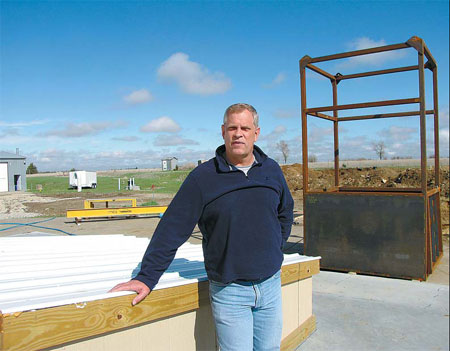Doomsday shelters in missile silo
|
Developer Larry Hall stands on top of survival condos and support services that reach 14 stories underground at a former missile silo north of Salina, Kansas. [Joe Lambe / Agence France-Presse] |
Tucked deep beneath the Kansas prairie, luxury condos are being built into the shaft of an abandoned missile silo to service anxious - and wealthy - people preparing for doomsday.
So far, four buyers have put down a total of about $7 million for havens to flee to when disaster happens or the end is nigh. And developer Larry Hall has options to retro-fit three more Cold War-era silos when this one fills up.
"They worry about events ranging from solar flares, to economic collapse, to pandemics to terrorism to food shortages," Hall told AFP on a tour of the site.
These "doomsday preppers", as they are called, want a safe place and he will be there with them because Hall, 55, bought one of the condos for himself. He says his fear is that sun flares could wipe out the power grid and cause chaos.
He and his wife and son live in Denver and will use their condo mostly as a vacation home, he says, but if the grid goes, they will be ready.
Hall isn't the first person to buy an abandoned nuclear missile silo and transform at least part of it into a shelter.
Built to withstand an atomic blast, even the most paranoid can find comfort inside concrete walls that are nine feet thick and stretch 53 meters underground.
Instead of simply setting up shop in the old living quarters provided for missile operators, Hall is building condos right up the missile shaft. Seven of the 14 underground floors will be condo space selling for $2 million a floor or $1 million a half floor. Three and a half units have been sold, two contracts are pending and only two more full units are available, Hall said.
For now, metal stairs stretch down to connect each floor but an elevator will later replace them. The units are within a steel and concrete core inside the original thick concrete, which makes them better able to withstand earthquakes.
He is also installing an indoor farm to grow enough fish and vegetables to feed 70 people for as long as they need to stay inside and also stockpiling enough dry goods to feed them for five years.
The top floor and an outside building above it will be for elaborate security. Other floors will be for a pool, a movie theatre and a library, and when in lockdown mode there will be floors for a medical center and a school.
Complex life support systems provide energy supplies from sources of conventional power, as well as windmill power and generators. Giant underground water tanks will hold water pre-filtered through carbon and sand.
And, of course, an elaborate security system and staff will keep marauding hordes out.
The condo elevator will only operate if a person's fingerprint matches its system, Hall said. Cameras will monitor a barbed-wire topped fence and give plenty of warning of possible intruders. Responses can range from a warning to lethal force.
"If they try to climb the fence we can stun them," he said. "If they want to break into the system, we can put an end to that."
Doomsday fears have flourished throughout history, but what once involved isolated pockets of fear now spreads worldwide through the media and Internet.
They have also expanded into the popular culture thanks to the success of dystopian fantasies such as "The Hunger Games" and a National Geographic reality show about those preparing for doomsday.
"Fear sells even better than sex," said John Hoopes, a professor in the anthropology department at the University of Kansas who has studied the spread of doomsday culture.
"Now the entire planet is involved and that's the result of the Internet," he said.
Agence France-Presse



















